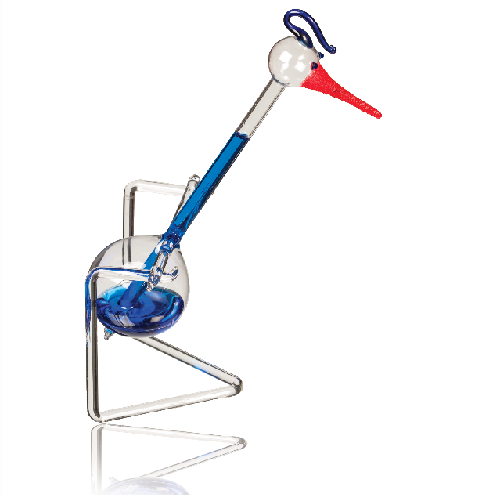Purpose:
- The purpose of this lab is to begin to consider the physics that takes place in the cooling system of the refrigerator. To do this we will examine and begin to explain a science toy known as the drinking bird. While this may seem outrageous it will require your understanding of a variety of physical concepts associated with gases and fluids. Here's an alternative motivation for the lab.
-
Procedure:
- For this lab I prefer not to give you any more clues than
necessary. I am curious how you will approach this problem without any overt
suggestions. Think of it as building on the experiences of the thermal properties and thermal conductivity labs. If you feel totally stuck at any point please ask for suggestions.
You may benefit from considering the folowing questions:
i) What happens to the volume of a gas as you heat and cool it?
ii) What happens to the pressure of a contained gas as it is heated and cooled?
iii) What happens to the boiling point of a fluid as the pressure changes?1) Read the instructions on the box and get your bird operating. Please note the cautions on the label - I expect all of the birds to survive the lab!!! An important consideration in their survival is not to twist their hats since this breaks a glass seal. Dropping them will also lead to permanent injury (to the bird!). Getting the bird running may take a while so be patient and observant.
2) Watch the bird through a number of cycles and begin to formulate questions that you are curious about. The idea here is to create questions that are specific enough that the answers are actually useful. What is the work that is atually done by the dippy bird? What is happening in the neck of the bird? How much energy is involved?
3) Based on the discussion within your group perform some tests to answer some of the questions to clarify what is happening. You are likely to find that your questions need refining. After everyone has had some time to do this we will gather as a class and share our findings.
4) Test the explanation you have formulated out on your fellow lab partners and the instructor to see if it holds water, so to speak. Look for inconsistencies between your explanation and what is actually observed.
Here's a picture you can use in your report or to help guide your thinking.

- LAB REPORT:
-
I) Find, on the web or via some other resource, a "complete" listing of the physical properties of the "mystery fluid" inside the Dippy Bird.
II) Find, on the web or via some other resource a reasonably detailed description of how the "Dippy Bird" is supposed to work. Identify, based on our classroom discussions, whether the description you found is wrong, flawed, or fundamentally correct. Quote the text from your source along with an appropriate citation - if you're not sure what this means ask!
III) Insert into your quoted description the physical evidence from your examination of the dippy bird that supports or contradicts the assertions made about each step of the process. There are many prudent ways of doing this so that it is evident which material is yours and which is from your source. Be aware that typically the web descriptions ignore the behavior in the "tail/butt" of the bird which is actually very important.
IV) Use the ideal gas law to calculate the proportional change in volume in the head due to the change in temperature of the gas in the head. This will tell you how far the fluid would need to rise to restore the pressure drop produced by the cooling of the gas. Why does this application of the ideal gas law seem inconsistent with the behavior of the bird?
V) Using physics from previous terms determine the power output (Joules/s = watts) of the dippy bird under laboratory conditions from the rate at which the active fluid is "lifted up". Show clearly how you determined this and what assumptions you needed to make.
